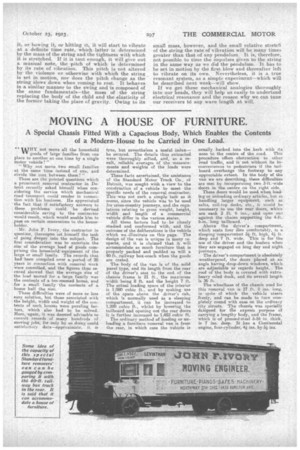MOVING A HOUSE OF FURNITURE.
Page 25

If you've noticed an error in this article please click here to report it so we can fix it.
A Special Chassis Fitted With a Capacious Body, Which Enables the Contents of a ModernHouse to be Carried in One Load.
" WHIT not move all the household " goods of large families from one place to another at, one time by a single motor vehicle? "
" Why not move two small families at the same time instead of one and divide the cost between them? "
These are the pointed questions which a prominent .removal contractor in Detroit recently asked himself when considering the service which mechanical road trensport could render in connection with his business. Ile appreciated the fact that if satisfactory answers to these problems could be devised considerable saving to the contractor would result, which would enable him to .pass on certain concessions to the householder.
Mr. John F. Ivory, the contractor in question, thereupon set himself the task of going deeper into the subject. The first consideration was to ascertain the size of the average load of goods comprising the household'equipment of the large or small family. The records that had been compiled over a: period of 20 years in connection with removal work were consulted, and the figures thus secured showed that the average size of the load moved for a large family was the contents of a ten-roomed house, and for a small family the contents of a house half the size.
These difficulties were of more or less easy solution, but those associated with the height, width and weight of the contents of such houses were puzzling feetors, which also had to be solved. Here, again, it was deemed advisable to conselt records of many hundreds of moving jobs; for Only by so doing Could satisfactoiy data—approsirdate, it is
true, but nevertheless a useful index— be secured. The details thus extracted were thoroughly sifted, and, as a result, reliable averages of the measurements and weights of the loads were determined.
These facts ascertained, the assistance of the Standard Motor Truck Go., of Detroit, was sought with a view to the construction of a vehicle to meet the specific needs of the removal contractor. This was not such a simple task as it seems, since the vehicle was to be used for cross-country journeys, and the regulations relating to gross weight, height, width and length of a commercial vehicle differ in the various states.
All these factors had to be closely studied and conformed with, and the outcome of the deliberations is the vehicle which we -illustrate on this page. The design of the van is unique in many respects, and it is claimed that it will accommodate as much furniture that is properly packed and padded as will a 40-ft. railway box-coach when the goods are crated.
The body of the van is of the solid panel type, and its length from the rear Of the driver's seat to the end of the chassis frame is 21 ft., the maximum width being 8 ft. and the height 7 ft.. The actual loading space of the interior is 1,080 cubic ft., and by making use of the space above the driver's cab, which is normally used as a sleeping compartment, it can be increased to 1,200. cubic ft.., whilst by lowering the tailboard and opening out the rear doors it is further increased to 1,452 cubic ft.
The ordinary method of loading or unloading a furniture removal van is from the rear, in which case the vehicle is
usually backed into the kerb with its nose to the centre of the road. This procedure offers obstruction to other road traffic, and is not without its inconveniences to pedestrians if the tailboard overhangs the footway. to a.ny appreciable extent. In the body of the van we are describing, these difficulties are met by incorporatiug two 3-ft-wide doors in the eentre on the right side.
These doors would be used when loadfrig or unloading ordinary articles, but in handling larger equipment, such as safes, roll-top desks, etc., it would be necessary to -use the rear doors, whien are each 3 ft. 6 ins., and open 00 against the chains supporting the 4-ft. 6-in. 'long tailboard. • Above the driver's compartment, which seats four ihen comfortably, is a sleeping c.ainportnibut, t. ft. high, 4& it. deep and 7 ft. wide. This is for the use of the driver and the loaders when they are engagedon long day and night journeys.
The driver's compartment is absolutely weatherproof, the doors placed at an angle having drop-down windows, which are adjustable as regards height.. The roof of the body is covered with extra heavy Oiled duck, and its overall length is 36 ft.. The wheelbase of the chassis used for this removal van is 17 ft. 8 ins. long,
' spite of which the vehicle steers freely, and can be made to turn completely round with ease on the ordinary city streets. The chassis was specially designed for the express purpose of carrying a lengthy body, and the frame, 'which is of pressed-steel 5-16 in. thick, is 7 ins. deep. It has a Continental engine, four-cylinder; 4 ins. by 4 ins.






























